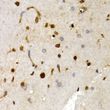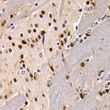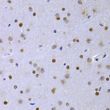SOX2 Rabbit Polyclonal Antibody
Other products for "SOX2"
Specifications
| Product Data | |
| Applications | IF, IHC, WB |
| Recommended Dilution | WB 1:500 - 1:2000;IHC 1:50 - 1:200;IF 1:50 - 1:200 |
| Reactivities | Human, Mouse, Rat |
| Host | Rabbit |
| Isotype | IgG |
| Clonality | Polyclonal |
| Immunogen | Recombinant protein of human SOX2 |
| Formulation | Store at -20°C (regular) and -80°C (long term). Avoid freeze / thaw cycles. Buffer: PBS with 0.02% sodium azide, 50% glycerol, pH7.3. |
| Concentration | lot specific |
| Purification | Affinity purification |
| Conjugation | Unconjugated |
| Storage | Store at -20°C as received. |
| Stability | Stable for 12 months from date of receipt. |
| Predicted Protein Size | 34 kDa |
| Gene Name | SRY-box 2 |
| Database Link | |
| Background | Embryonic stem cells are derived from the inner cell mass of the blastocyst and are unique in their pluripotent capacity and potential for self-renewal. Sox2 is one of a set of transcription factors that are crucial for the maintenance of pluripotency (1). Sox2, Oct-4, and Nanog cooperate in this network (1-3), and siRNA knockdown of either Sox2 or Oct-4 results in loss of pluripotency (4,5). Chromatin immunoprecipitation experiments have shown that Sox2 and Oct-4 bind to thousands of gene regulatory sites, highlighting the importance of these transcription factors in early embryonic development (6,7). It has recently been shown that Sox2 is amplified in lung and esophageal squamous cell tumors (8). |
| Synonyms | ANOP3; MCOPS3 |
| Reference Data | |
| Protein Families | Adult stem cells, Cancer stem cells, Embryonic stem cells, ES Cell Differentiation/IPS, Induced pluripotent stem cells, Transcription Factors |
Documents
| Product Manuals |
| FAQs |
{0} Product Review(s)
0 Product Review(s)
Submit review
Be the first one to submit a review
Product Citations
*Delivery time may vary from web posted schedule. Occasional delays may occur due to unforeseen
complexities in the preparation of your product. International customers may expect an additional 1-2 weeks
in shipping.






























































































































































































































































 Germany
Germany
 Japan
Japan
 United Kingdom
United Kingdom
 China
China







